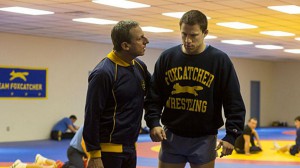New York Film Festival 2014, Part Four: The Reel Deal
 Bennett Miller likes to use newspaper stories as the jumping off point for his movies because, as he said at his press conference, journalism compresses important events for easy, quick comprehension and that tempts him to pry them open and reveal how incomprehensible they really are. He does just that in Foxcatcher, his fictionalized version of the troubled relationship between Olympic wrestling champion David Shultz and John Dupont, who opened up his very deep pockets during the 1980s to support the Olympic team. A similar desire is present in two other Main Slate films at NYFF 2014: Tales of the Grim Sleeper, a documentary made by Nick Broomfield, about a serial killer in South Central Los Angeles; and Clouds of Sils Maria, directed by Oliver Assayas, a completely fictional feature about an actress preparing for a new role in more ways than one. There is a kind of genius in these films, each of which is a different adventure in storytelling. This year’s NYFF finished at the top of its game.
Bennett Miller likes to use newspaper stories as the jumping off point for his movies because, as he said at his press conference, journalism compresses important events for easy, quick comprehension and that tempts him to pry them open and reveal how incomprehensible they really are. He does just that in Foxcatcher, his fictionalized version of the troubled relationship between Olympic wrestling champion David Shultz and John Dupont, who opened up his very deep pockets during the 1980s to support the Olympic team. A similar desire is present in two other Main Slate films at NYFF 2014: Tales of the Grim Sleeper, a documentary made by Nick Broomfield, about a serial killer in South Central Los Angeles; and Clouds of Sils Maria, directed by Oliver Assayas, a completely fictional feature about an actress preparing for a new role in more ways than one. There is a kind of genius in these films, each of which is a different adventure in storytelling. This year’s NYFF finished at the top of its game.
Foxcatcher takes its name from Foxcatcher Farm in Pennsylvania, owned by the Dupont family, the location of Bennett Miller’s stunning tale of masculinity at the edge, childhood deprivation, and the disastrous magnification of personal instability by untold wealth. From the outset, surface appearances tease thought. The film opens on a man in a seedy gym doing battle with a leather object of humanoid shape. Who is he? What is the meaning of his fierce and desperate determination? What is the nature of his relationship with a man who soon takes the place of the dummy? What sport is involved here? Is it a sport? Is this a sports movie?
 The men in question are brothers, Mark and David Shultz, in order of appearance, and the questions inspired by this initial encounter correctly predict there will be many more generated by every encounter in the film. It doesn’t take long to discover that this is a story about Olympic wrestlers, but it is like no sports movie that has ever been made. The typical cinematic treatment of contact sports follows the linear pattern of the boxing movies of the 1930s-1950s which mandates that a champion-in-the-making triumph over some kind of pretty clear peril. Screenwriting 101. By contrast, Foxcatcher, with its slow, graceful, accumulation of the pieces of its collage, unfolds to reveal the separate, various, and never entirely clear, underlying motivations of Mark and David Shultz, and John Eleuthere Dupont, in their collective determination to bring home Olympic gold. When the final shot fades, the big picture of the events that transpire, which I will not reveal in the hope that you will come to this amazing film with fresh eyes, remains a morass of idealism, emotional disturbance, and uncontrolled love and rage.
The men in question are brothers, Mark and David Shultz, in order of appearance, and the questions inspired by this initial encounter correctly predict there will be many more generated by every encounter in the film. It doesn’t take long to discover that this is a story about Olympic wrestlers, but it is like no sports movie that has ever been made. The typical cinematic treatment of contact sports follows the linear pattern of the boxing movies of the 1930s-1950s which mandates that a champion-in-the-making triumph over some kind of pretty clear peril. Screenwriting 101. By contrast, Foxcatcher, with its slow, graceful, accumulation of the pieces of its collage, unfolds to reveal the separate, various, and never entirely clear, underlying motivations of Mark and David Shultz, and John Eleuthere Dupont, in their collective determination to bring home Olympic gold. When the final shot fades, the big picture of the events that transpire, which I will not reveal in the hope that you will come to this amazing film with fresh eyes, remains a morass of idealism, emotional disturbance, and uncontrolled love and rage.
The cast is flawless. Channing Tatum, as Mark Shultz, fills the screen with the almost unbearable vulnerability of a slow thinking, physically powerful man who will always remain the neglected child he was. Mark Ruffalo, as David Shultz, a product of the same neglect, radiates the hard won warmth and competence of a man who inexplicably retained his capacity to give and receive love despite his virtual abandonment by his parents. Magically, the two actors convey the viscerality of these wrestlers in two different keys, like a pair of musical motifs threading a complex score. But it is Steve Carell, an actor synonymous with light comedy, who turns in the performance of the year, and of his life to date, as John Dupont, the quietly twisted heir to a family fortune that is about as old as the United States itself. Dupont’s body language bespeaks a man who craves but fails to achieve a “manly” physical existence. His every appearance in the film—and he is on screen often—would be extremely funny if it weren’t so savagely threatening simply because Dupont clearly has no idea who he is underneath his platitudinous old money American optimism that if you enter a competition confidently, you will win. In many ways, he is one of the most desolate characters ever to appear onscreen.
As is evident, Foxcatcher is dominated by men, and yet the presence of Dupont’s mother, Jean (Vanessa Redgrave), and David Shultz’s wife, Nancy (Sienna Miller) are indispensable to any understanding of what is roiling beneath the surface. This is particularly true of Jean Dupont. Redgrave appears in three brief scenes and says very little in any of them, but the tenor of her powerful presence makes you feel that she is the wordless explanation, if one could only read it, of what has made her son the way he is. Similarly, somehow we come away feeling that we have witnessed not only personal histories, but the history of the United States, a bellwether for the future—unless there is something we can glean from these tormented souls that will help us to do better.
 Equally pregnant with subtext is Nick Broomfield’s Tales of the Grim Sleeper, a model of ethnographic documentary, reflecting Broomfield’s training by documentarian Colin Young at the National Film School in Great Britain to be respectful when venturing onto the territory of groups wary of outsiders. Investigating the twenty-five year career of mass murderer Lonnie Franklin Jr., Broomfield was challenged to find a way to gain the trust of one of the most understandably mistrustful areas of the city. He came into South Central Los Angeles with his camera at the end of Franklin’s long rampage that the police did nothing to stop and his investigation makes clear that the department was monumentally lax because it had simply written off the black population. Ask the women of The Black Coalition Fighting Back Serial Murders. The police dismissed their concerns saying in so many words that the “Grim Sleeper’s” victims were “only hookers.” (Their slang term for black-on-black crime was NHI, No Humans Involved.) Yet if the police had bothered to ask almost anyone who lived on Franklin’s street, they would have had abundant evidence to stop him in the early years of his rampage.
Equally pregnant with subtext is Nick Broomfield’s Tales of the Grim Sleeper, a model of ethnographic documentary, reflecting Broomfield’s training by documentarian Colin Young at the National Film School in Great Britain to be respectful when venturing onto the territory of groups wary of outsiders. Investigating the twenty-five year career of mass murderer Lonnie Franklin Jr., Broomfield was challenged to find a way to gain the trust of one of the most understandably mistrustful areas of the city. He came into South Central Los Angeles with his camera at the end of Franklin’s long rampage that the police did nothing to stop and his investigation makes clear that the department was monumentally lax because it had simply written off the black population. Ask the women of The Black Coalition Fighting Back Serial Murders. The police dismissed their concerns saying in so many words that the “Grim Sleeper’s” victims were “only hookers.” (Their slang term for black-on-black crime was NHI, No Humans Involved.) Yet if the police had bothered to ask almost anyone who lived on Franklin’s street, they would have had abundant evidence to stop him in the early years of his rampage.
Broomfield found the evidence within a period of weeks. Shooting the documentary without a script, he let the facts determine the film’s structure, and as facts emerge the attitudes of the people of South Central begin to change visibly toward Broomfield’s questions. Discovering that someone actually cares about what is going on, three men who began by vigorously defending Franklin request follow-up interviews to confide highly incriminating information about him. Even more important, Broomfield gains the trust of Pam, a woman who had been an independent (pimpless) street prostitute for many years and was able to encourage the people she knew to talk candidly on camera.
The revelation of Tales of the Grim Sleeper, and its subtext, is not police malfeasance, however, but the dignity of so many invisible, all but dispossessed Americans. The dignity with which they discuss their lives and the lives of the people around them is shattering. They exhibit far less tendency to denial and self-deception than many of the fortunate, highly visible Americans we see daily on the news. As the case against Franklin becomes more and more substantial, we increasingly understand the irony and resilience with which his neighbors fight to maintain their self-respect while the legal system drags its feet. It is impossible to watch unmoved. I have heard, with disgust, some privileged Americans voice the opinion that such people are better off dead. Broomfield’s film only strengthens my belief that they have no self respect. They love only their affluence, not the human essence that is the sole point of pride of the people to whom Broomfield introduces us.
 Finally, we turn to Olivier Assayas’ Clouds of Sils Maria, an incandescent portrait of aging, creativity and the complex interplay of motives among women. Did you know that there is a valley in the Swiss Alps, over which the clouds roll in the shape of a serpent every morning? This is the key image in Assayas’ film, but like everything else in it, the metaphor will not reveal itself effortlessly to you. And I won’t either. You have to work.
Finally, we turn to Olivier Assayas’ Clouds of Sils Maria, an incandescent portrait of aging, creativity and the complex interplay of motives among women. Did you know that there is a valley in the Swiss Alps, over which the clouds roll in the shape of a serpent every morning? This is the key image in Assayas’ film, but like everything else in it, the metaphor will not reveal itself effortlessly to you. And I won’t either. You have to work.
The story is simple. Maria Enders (Juliette Binoche), a highly intelligent actress at the peak of her career, is traveling with her assistant Valentine (Kristen Stewart—yes, THE Kristen Stewart, who, it turns out, can really act) to accept an award on behalf of the reclusive playwright who penned the play that twenty years previously made her a star. En route, she receives news of his death and soon after gets an intriguing offer.
Her breakout role long ago was as Sigrid, a conniving vixen who seduces her boss, Helena, a mature woman unsure of what approaching old age holds for her, in an “All About Eve” ploy to replace her. Maria is now asked to star in a new production of the play, but in the role of Helena. Assayas, Binoche, Stewart, and Chloe Moretz, as Jo-Ann Ellis the “wild child” Hollywood actress who will play Sigrid in the new production, brilliantly weave the threads of desire, ambition, artistry, and anxiety that intertwine in the subtext under these events.
Who, we begin to wonder, is manipulating whom, as Maria struggles to enter into the emotions of a character who is roughly in the same daunting position she faces in her own life? It seems that all the power is on the side of the young women, and that Maria is now living the victimization of Helena. But possibly not. There are indications that, all appearances to the contrary, Maria is masterfully drawing the young women into her web, in order to use them off-stage to find her on-stage character. The final twist, however, is that no matter how well she parries the competition, the implacable truth of approaching old age remains. Maria cannot escape THAT through art. This is a wondrous film that will not get nearly enough distribution, even in art houses. Catch it while you can; you’ll be missing a small masterpiece if you don’t.
Same time, next year at NYFF 2015? 
This post is part of an ongoing partnership between Antenna: Responses to Media & Culture and the Society for Cinema & Media
Studies’ Cinema Journal.


